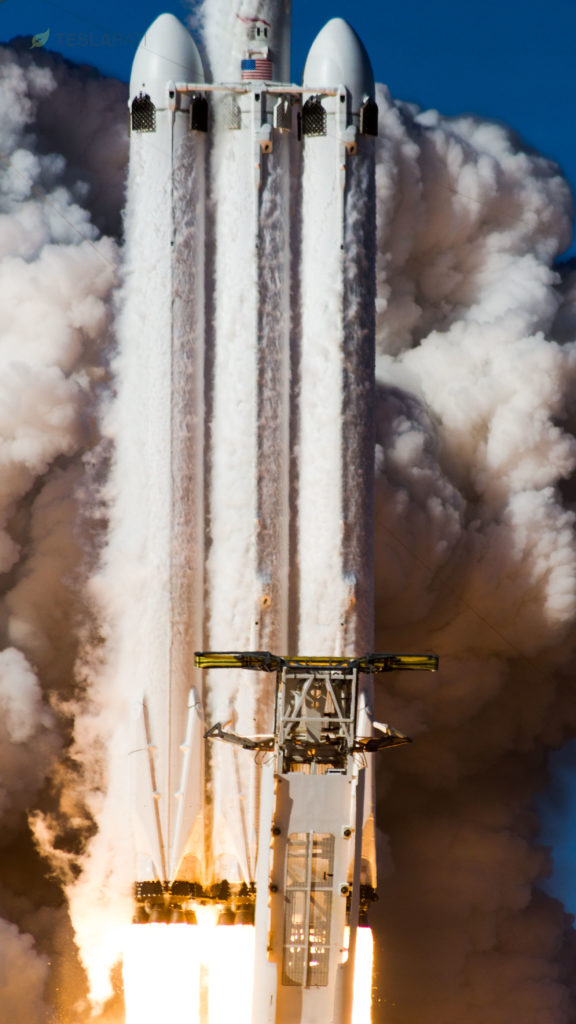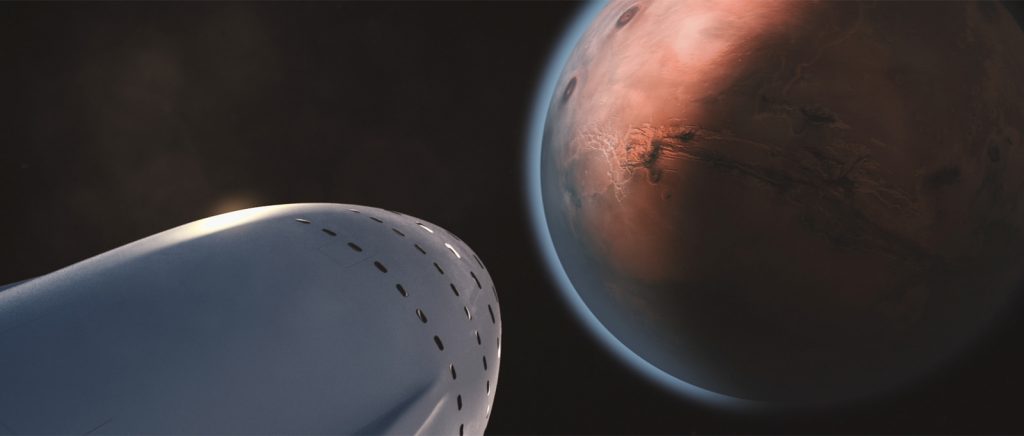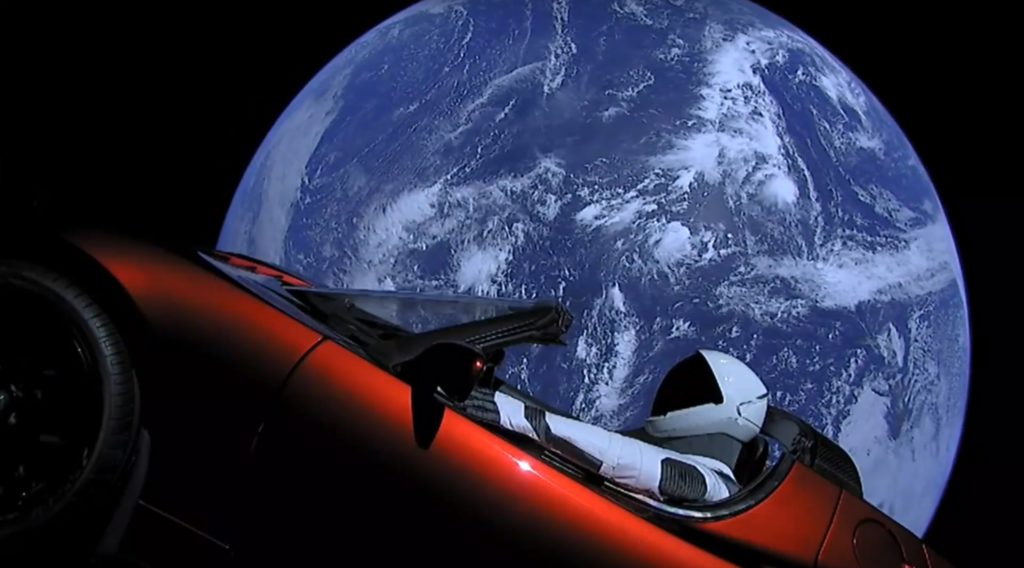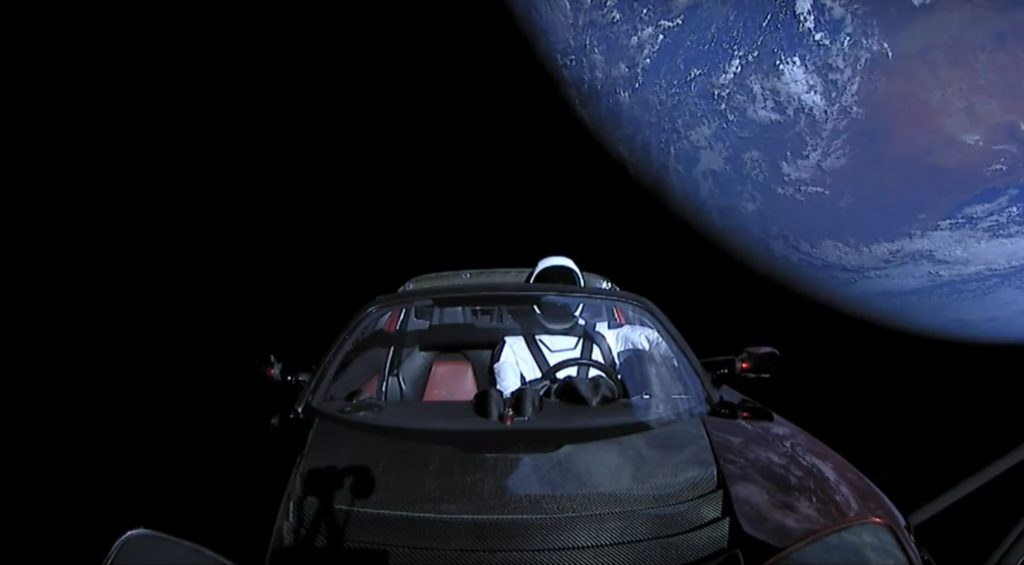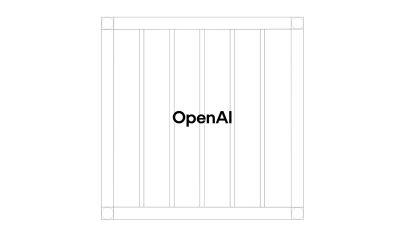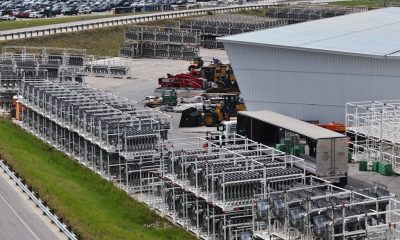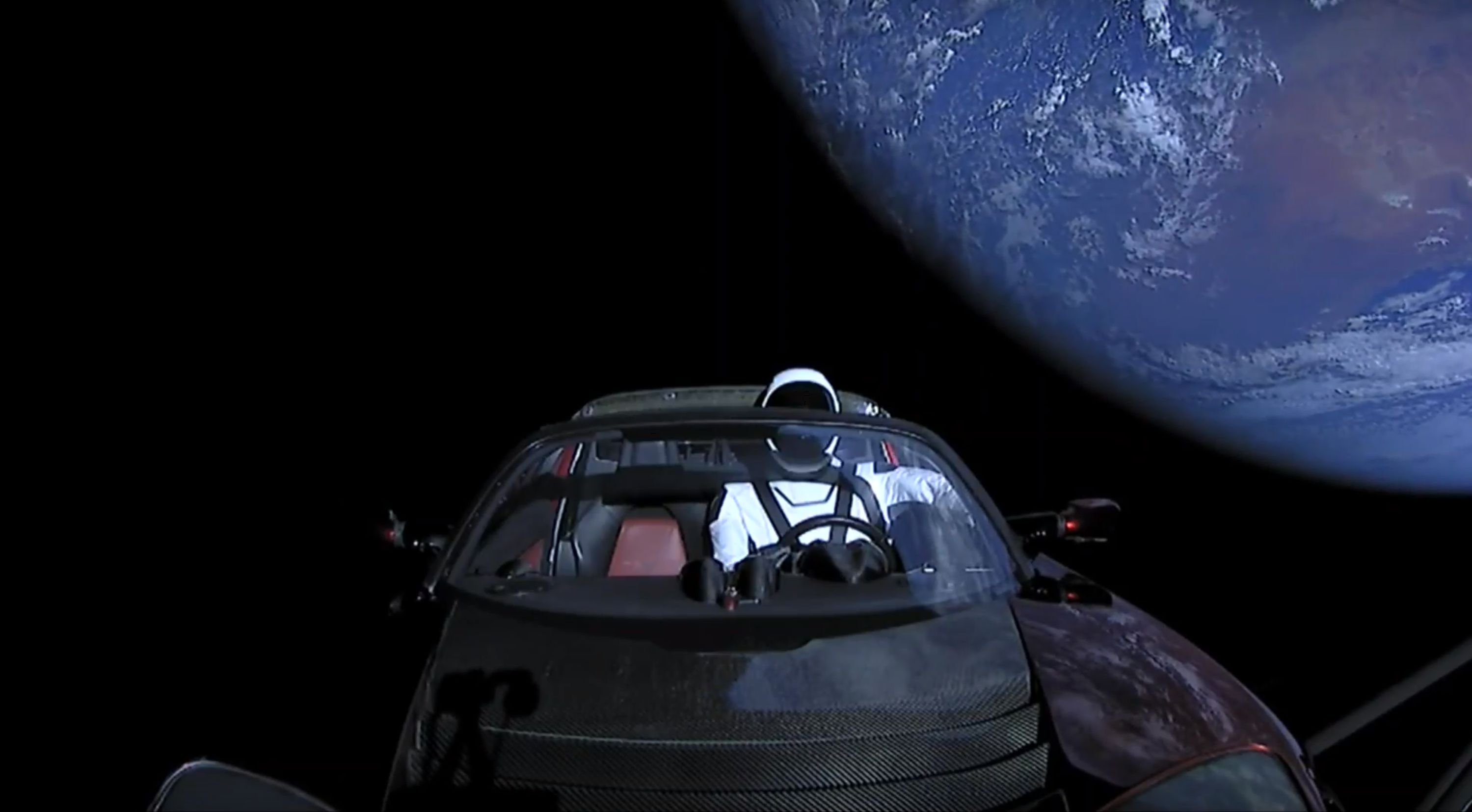

News
What will happen to Elon Musk’s Tesla on its space journey to Mars?
SpaceX has completed the last crucial step of Falcon Heavy’s inaugural test flight after successfully launching Elon Musk’s Tesla Roadster out of Earth’s orbit, on a trajectory into deep space. But what will happen to the car and ‘Starman’ as it makes its long journey to Mars? Let us explore the details.
Although Elon Musk indicated that the Tesla had been placed in an orbit that would nearly extend to the beginnings of the solar system’s first asteroid belt (on average more than 150 million miles away from Earth’s orbit), SpaceX updated that orbit estimate about 24 hours later and confirmed that the orbit was considerably closer to Mars’ orbit than the asteroid belt beyond the Red Planet.

Starman gives one final farewell to Earth as he departs for deep space aboard Musk’s Tesla Roadster. (SpaceX)
Understandably, the ultimate destination and state of the Roadster have been the source of an array of questions from those less familiar with interplanetary travel and orbital mechanics – most people.
How exactly does space travel work?
Before delving into the details, it’s crucial that I try to give everyone equal footing in the form of a basic understanding of what, how, and whens of spaceflight. To reach orbit, Falcon Heavy launched its Tesla payload horizontally. Once it rose vertically above the majority of Earth’s atmosphere, the rocket angled over until it was essentially thrusting parallel to Earth’s surface. Think of it like spinning a ball on a string: only after a certain speed will the ball successfully spin in a circle – spin too slow and the ball will simply fall. Reaching Earth orbit is very similar in concept: Falcon Heavy boosts the upper stage above Earth’s atmosphere, and the upper stage ignites and gains as much horizontal speed as possible.
All this time, both it and its Tesla payload are being pulled down by Earth’s gravity, but at a certain speed (8 kilometers per second, or ~18,000 mph), the rocket and its payload end up going faster around the Earth than its gravity can pull them down. A famous analogy can be found in a simple tennis ball: thrown normally, the ball will arc over and eventually fall to the ground. However, if a ball is thrown fast enough (and was also able to avoid being incinerated by friction against the atmosphere), one can imagine the ball going over the horizon, traveling around the Earth, and coming right back to the thrower.

Elon Musk walks among his recovered Falcon Heavy boosters at LZ-1 and 2. (Elon Musk)
Throwing a ball (or spaceship) into orbit
Amazingly, this becomes a far more reasonable proposition when dealing with asteroids, comets, and moons with much light gravity than Earth’s “1G.” For example, on Mars’ tiny moon Phobos, an astronaut could very nearly escape from the moon by running, and could almost effortlessly throw a ball fast enough to orbit Phobos (a blistering 25 mph would be required). Earth is just like that, just much, much, much larger, and with a thick atmosphere that both keeps us, humans, alive and also makes it quite a bit more difficult for us to get into orbit.
Back to Earth orbit. The first point of stability (when you are going faster forward than the Earth can pull you down) is called “low Earth orbit,” (LEO) being roughly the lowest height and velocity necessary to stably orbit the Earth. This is approximately where the International Space Station (ISS) is located (~ 250 miles above). Famously, astronauts and satellites at this altitude travel around the Earth once every 90 minutes, half in pure sunlight, half in the darkness of Earth’s own shadow – essentially a special sunrise and sunset every three-quarter of an hour.

Mars’ largest moon Phobos captured at the edge of the planet’s limb. Phobos is less than 15 miles in diameter. (ESA/Mars Express)
Now, expand that model of Earth and the Roadster in orbit around it to the entire solar system. In this model, Earth and all other objects are orbiting the Sun at different distances and speeds, like different bands of the same tree ring. The solar system is massive, however, and thus everything has to be scaled up: for example, the Earth orbits the Sun at 30 kilometers per second (~70,000 mph), nearly four times faster than our humble Tesla in LEO.
Remember: when orbiting Earth, objects are still under the firm hold of the planet’s gravity, but merely moving so fast that they are in a constant state of freefall. Take away the air, and being on the ISS is akin to skydiving, but if the skydive never ended. To truly escape Earth’s gravity and head to the Moon, Mars, or beyond, a rocket needs to go even faster still. In the case of the Roadster, this meant first speeding up to 8 km/s to reach a stable orbit around Earth, followed several hours later by one final burn that gave the payload another 3-4 km/s of speed. On the scale of the solar system, Roadster’s journey away from Earth can be thought of like, well, a Roadster making its way to the top of a steep hill. After climbing to the top, the Roadster is nearly out of energy but has just enough to accelerate as it begins its way down the other side. About six hours after launch, the rocket’s upper stage successfully crested the summit of Earth’s gravitational hill before rocketing down the other side, on its way to deep space, Mars, and beyond.
In essence, the rocket moved Musk’s Tesla from an orbit around Earth to an orbit around the Sun itself. Just as Earth takes 365 days (a year) to travel once around the Sun, the Roadster will complete an orbit of the sun every once in awhile, likely closer to the two Earth years it takes for Mars to complete its orbit. Similarly, evidenced by Earth and all the other planets in the solar system, orbiting the sun is typically very stable – humans do not exactly live in fear of the Earth falling into the sun, we just keep going around and around. Like the planets, Musk’s Roadster will almost certainly remain in its current orbit for millions of years – maybe even a billion years – quietly completing an orbit around the sun every two or so years for what is effectively an eternity on a human scale. Eventually, it’s possible that the Roadster and Starman will be pulled over time by the gravity of Earth in such a way that it reenters Earth’s atmosphere and burns up, but that is unlikely to happen for thousands of millennia.
Where is the Roadster headed?
The graphic tweeted by Musk serves as a good initial explanation of complex terms used to describe orbital mechanics. Because it is not circular, the orbit is known as elliptical, while the points closest to (perihelion) and furthest from (aphelion) the Sun also have their special names. The AU mentioned in the graphic refers to astronomical units, a standard measurement based upon the average distance between the Earth and the Sun – approximately 93 million miles. For comparison, a full trip around the Earth’s equator is a little less than 25,000 miles. Space is unfathomably immense.
Third burn successful. Exceeded Mars orbit and kept going to the Asteroid Belt. pic.twitter.com/bKhRN73WHF
— Elon Musk (@elonmusk) February 7, 2018
- Falcon Heavy explodes off of Pad 39A in a spectacle of fire, Roadster in tow. (Tom Cross)
- The Roadster’s orbit will reach out on one end as far as Mars, SpaceX’s ultimate destination as a company. (SpaceX)
Falcon Heavy’s upper stage appears to have simply burned until it ran out of fuel, and managed with the far end of its orbit at about 1.61 astronautical units (~250 million km) is considerably less than Musk’s pre-launch press conference suggestion that the Roadster was expected to end up in an orbit of 380 to 450 million kilometers.
Musk: If the third burn goes as we hope, the Tesla will get as far away as 380 to 450 million km from Earth.
— Eric Berger (@SciGuySpace) February 5, 2018
Is the Roadster going to Mars?
Sadly, the answer is a hard “no.” At most, the Tesla might have been sent into an orbit around the sun (heliocentric orbit) with a very close approach to Mars – a flyby, so to speak. It appears that SpaceX managed to get quite close to that original goal, and it is entirely possible that Starman’s Roadster could pass close to Mars at points along its orbit, although there will be no way to capture or transmit images from the Roadster.

While there will be no cameras to capture it, it looks like Starman could actually – one day – pass close to the Red Planet on his billion year journey. (SpaceX)
Perhaps most importantly, to launch the Roadster into such a high orbit, SpaceX had to ensure that the rocket’s upper stage could coast for multiple hours in Earth orbit and still be able to precisely reignite its Merlin Vacuum (MVac) engine for a final burn. By successfully accomplishing precisely that, SpaceX has taken a huge step towards being able to compete with the United Launch Alliance for all government and defense-related launch contracts, even those requiring direct placement into geostationary orbit (GEO), versus a slower but more common geostationary transfer orbit (GTO). Not coincidentally, that capability also means that SpaceX can efficiently send payloads beyond Earth orbit, as they have now done for the first time with Musk’s Tesla Roadster.
How long will it take?
Because the Roadster is not actually going to any planets, moons, or asteroids, it will never reach them. However, the electric car’s newfound orbital home means that it will at least be far, far from Earth – at points, it’s trajectory will cross closest to the orbits of Mars and Earth. It will take a minimum of several months for the Roadster to reach those distances, even at its blistering speed of 12 kilometers per second relative to Earth. Jonathan McDowell, a practicing astronomer, estimated that the Roadster would pass Mars orbit – to be clear, not arriving at Mars, simply reaching the same distance away from the Sun as Mars orbits – in July 2018, approximately five months from today.
Corrected orbital data for the Roadster: 0.99 x 1.71 AU x 1.1 deg
C3 = 12.0, passes orbit of Mars Jul 2018, aphelion November— Jonathan McDowell (@planet4589) February 8, 2018
What’s going to happen to Starman and the Roadster?
Soaring through the hard vacuum of deep space, not a whole lot can be expected to happen to Elon Musk’s Tesla Roadster and Starman. As mentioned, the high heliocentric orbit it was placed in will be incredibly stable, likely allowing the car to remain in deep space for tens of millions of years. Now, that is not to say that future human explorers millions of years from now would recognize whatever remained – deep space is characterized by a relatively extreme radiation environment that will not be kind to many components that make up the Roadster’s structure. Carbon fiber, plastic, leather, and paint all contain organic components that will be assaulted by an environment far harsher than that in and around Earth.
- Elon’s Tesla Roadster and his astronaut stand-in. (Elon Musk)
- . . . . . . . . yep. This is a thing, now. (SpaceX)
Still, hyperbolic claims that “Radiation Will Tear Elon Musk’s Rocket Car to Bits in a Year” are ridiculously exaggerated. Vacuum is characterized by the absence of anything, and that includes all conceivable methods of erosion. While high energy radiation found in deep space can and likely will shred the Tesla’s structural integrity and eventually bleach or discolor the car, the Roadster will be perfectly suspended in microgravity (basically zero gravity) conditions with almost no chance whatsoever of impacts by even tiny space debris like micrometeorites. If an aspiring car collector tried to recover the eccentric and historic trophy from space in several centuries/millennia, Roadster would very likely fall to pieces or even crumble to dust when moved or placed in an environment with any significant gravity. But, it will almost without a doubt retain its recognizable shape almost indefinitely, at least on a human scale. Starman can be expected to react very similarly.
hyperbolic claims that “Radiation Will Tear Elon Musk’s Rocket Car to Bits in a Year” are ridiculously exaggerated.
Finally, it appears that SpaceX has not installed any method of power generation or communication on Starman’s ride, meaning that humans likely saw their last views of the vehicle after SpaceX cut the live feed to Starman. This sadly means that there will be no photo ops with Starman soaring past Mars or exploring the asteroid belt, although that option will certainly be reserved for any future eccentric, Muskian test payloads.
Why does sending a car into deep space matter?
Ultimately, this final success is an invaluable cherry on top of what was already a stunning achievement. Without a single scrubbed launch attempt or unintended hold during the final countdown, SpaceX’s first launch of what is now the most capable operational rocket in the world was a perfect success in almost all regards. Although the massive rocket’s center booster failed to land aboard the drone ship Of Course I Still Love You (OCISLY) due to an apparent shortage of the chemical components used to reignite the booster’s engines, both side boosters were recovered on land with what can only be described as well-oiled expertise. Meanwhile, the rocket simply survived the launch in general, didn’t destroy the pad, successfully tested its unproven side booster separation mechanism, and launched an eccentric payload into the highest orbit yet achieved by the commercial launch company.
- It’s easy to understand why Musk himself laughed about Roadster looking very much like CGI. (SpaceX)
- Is this real life? Who knows anymore. (SpaceX)
- . . . . . . . . yep. This is a thing, now. (SpaceX)
In the case of Elon Musk, it certainly appears that it is possible to – at least once and awhile – have one’s cake and eat it too. Follow along live as launch photographer Tom Cross and I cover these exciting proceedings as close to live as possible.
Teslarati – Instagram – Twitter
Tom Cross – Twitter
Eric Ralph – Twitter
News
These Tesla, X, and xAI engineers were just poached by OpenAI
The news is the latest in an ongoing feud between Elon Musk and the Sam Altman-run firm OpenAI.

OpenAI, the xAI competitor for which Elon Musk previously served as a boardmember and helped to co-found, has reportedly poached high-level engineers from Tesla, along with others from xAI, X, and still others.
On Tuesday, Wired reported that OpenAI hired four high-level engineers from Tesla, xAI, and X, as seen in an internal Slack message sent by co-founder Greg Brockman. The engineers include Tesla Vice President of Software Engineering David Lau, X and xAI’s head of infrastructure engineering Uday Ruddarraju, and fellow xAI infrastructure engineer Mike Dalton. The hiring spree also included Angela Fan, an AI researcher from Meta.
“We’re excited to welcome these new members to our scaling team,” said Hannah Wong, an OpenAI spokesperson. “Our approach is to continue building and bringing together world-class infrastructure, research, and product teams to accelerate our mission and deliver the benefits of AI to hundreds of millions of people.”
Lau has been in his position as Tesla’s VP of Software Engineering since 2017, after previously working for the company’s firmware, platforms, and system integration divisions.
“It has become incredibly clear to me that accelerating progress towards safe, well-aligned artificial general intelligence is the most rewarding mission I could imagine for the next chapter of my career,” Lau said in a statement to Wired.
🚨Optimistic projections point to xAI possibly attaining profitability by 2027, according to Bloomberg's sources.
If accurate, this would be quite a feat for xAI. OpenAI, its biggest rival, is still looking at 2029 as the year it could become cash flow positive.💰 https://t.co/pE5Z9daez8
— TESLARATI (@Teslarati) June 18, 2025
READ MORE ON OPENAI: Elon Musk’s OpenAI lawsuit clears hurdle as trial looms
At xAI, Ruddarraju and Dalton both played a large role in developing the Colossus supercomputer, which is comprised of over 200,000 GPUs. One of the major ongoing projects at OpenAI is the company’s Stargate program,
“Infrastructure is where research meets reality, and OpenAI has already demonstrated this successfully,” Ruddarraju told Wired in another statement. “Stargate, in particular, is an infrastructure moonshot that perfectly matches the ambitious, systems-level challenges I love taking on.”
Elon Musk is currently in the process of suing OpenAI for shifting toward a for-profit model, as well as for accepting an investment of billions of dollars from Microsoft. OpenAI retaliated with a counterlawsuit, in which it alleges that Musk is interfering with the company’s business and engaging in unfair competition practices.
Elon Musk confirms Grok 4 launch on July 9 with livestream event
News
SpaceX share sale expected to back $400 billion valuation
The new SpaceX valuation would represent yet another record-high as far as privately-held companies in the U.S. go.

A new report this week suggests that Elon Musk-led rocket company SpaceX is considering an insider share sale that would value the company at $400 billion.
SpaceX is set to launch a primary fundraising round and sell a small number of new shares to investors, according to the report from Bloomberg, which cited people familiar with the matter who asked to remain anonymous due to the information not yet being public. Additionally, the company would sell shares from employees and early investors in a follow-up round, while the primary round would determine the price for the secondary round.
The valuation would represent the largest in history from a privately-owned company in the U.S., surpassing SpaceX’s previous record of $350 billion after a share buyback in December. Rivaling company valuations include ByteDance, the parent company of TikTok, as well as OpenAI.
Bloomberg went on to say that a SpaceX representative didn’t respond to a request for comment at the time of publishing. The publication also notes that the details of such a deal could still change, especially depending on interest from the insider sellers and share buyers.
Axiom’s Ax-4 astronauts arriving to the ISS! https://t.co/WQtTODaYfj
— TESLARATI (@Teslarati) June 26, 2025
READ MORE ON SPACEX: SpaceX to decommission Dragon spacecraft in response to Pres. Trump war of words with Elon Musk
SpaceX’s valuation comes from a few different key factors, especially including the continued expansion of the company’s Starlink satellite internet company. According to the report, Starlink accounts for over half of the company’s yearly revenue. Meanwhile, the company produced its 10 millionth Starlink kit last month.
The company also continues to develop its Starship reusable rocket program, despite the company experiencing an explosion of the rocket on the test stand in Texas last month.
The company has also launched payloads for a number of companies and government contracts. In recent weeks, SpaceX launched Axiom’s Ax-4 mission, sending four astronauts to the International Space Station (ISS) for a 14-day stay to work on around 60 scientific experiments. The mission was launched using the SpaceX Falcon 9 rocket and a new Crew Dragon capsule, while the research is expected to span a range of fields including biology, material and physical sciences, and demonstrations of specialized technology.
News
Tesla Giga Texas continues to pile up with Cybercab castings
Tesla sure is gathering a lot of Cybercab components around the Giga Texas complex.

Tesla may be extremely tight-lipped about the new affordable models that it was expected to start producing in the first half of the year, but the company sure is gathering a lot of Cybercab castings around the Giga Texas complex. This is, at least, as per recent images taken of the facility.
Cybercab castings galore
As per longtime drone operator Joe Tegtmeyer, who has been chronicling the developments around the Giga Texas complex for several years now, the electric vehicle maker seems to be gathering hundreds of Cybercab castings around the factory.
Based on observations from industry watchers, the drone operator appears to have captured images of about 180 front and 180 rear Cybercab castings in his recent photos.
Considering the number of castings that were spotted around Giga Texas, it would appear that Tesla may indeed be preparing for the vehicle’s start of trial production sometime later this year. Interestingly enough, large numbers of Cybercab castings have been spotted around the Giga Texas complex in the past few months.
Cybercab production
The Cybercab is expected to be Tesla’s first vehicle that will adopt the company’s “unboxed” process. As per Tesla’s previous update letters, volume production of the Cybercab should start in 2026. So far, prototypes of the Cybercab have been spotted testing around Giga Texas, and expectations are high that the vehicle’s initial trial production should start this year.
With the start of Tesla’s dedicated Robotaxi service around Austin, it might only be a matter of time before the Cybercab starts being tested on public roads as well. When this happens, it would be very difficult to deny the fact that Tesla really does have a safe, working autonomous driving system, and it has the perfect vehicle for it, too.
-

 Elon Musk1 week ago
Elon Musk1 week agoTesla investors will be shocked by Jim Cramer’s latest assessment
-

 News2 weeks ago
News2 weeks agoTesla Robotaxi’s biggest challenge seems to be this one thing
-

 Elon Musk1 day ago
Elon Musk1 day agoElon Musk confirms Grok 4 launch on July 9 with livestream event
-

 News2 weeks ago
News2 weeks agoWatch the first true Tesla Robotaxi intervention by safety monitor
-

 News5 days ago
News5 days agoTesla Model 3 ranks as the safest new car in Europe for 2025, per Euro NCAP tests
-

 Elon Musk2 weeks ago
Elon Musk2 weeks agoA Tesla just delivered itself to a customer autonomously, Elon Musk confirms
-

 Elon Musk2 weeks ago
Elon Musk2 weeks agoElon Musk confirms Tesla Optimus V3 already uses Grok voice AI
-

 Elon Musk2 weeks ago
Elon Musk2 weeks agoxAI welcomes Memphis pollution results, environmental groups push back

